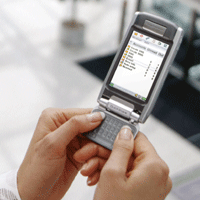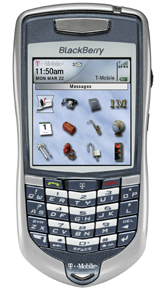Who would have thought the day would come when laptops would seem too big, and phones not useful enough? Yet that's precisely why handheld PCs have become so popular among mobile workers. The devices combine the data-gathering and data-transmitting capabilities of a personal digital assistant with the voice capabilities of a cellular phone. For many agencies, handhelds are becoming the tool of choice.The attraction lies in their combination of features in such a small package. You can input information in several ways, for example. Some offer small, built-in keyboards'in QWERTY, ABC and other layouts. Others have touch screens for making selections with a finger or stylus. A few offer handwriting recognition. Many permit combinations of all three. In addition, some devices include a camera'either still or digital video. Handhelds also can run applications of varying sophistication, depending on the model. Any that permit Internet access include a browser, either rudimentary or full-featured. All include calculators, contact lists for names and phone numbers, calendars and to-do lists.Viewers for many document and image types are available. Simple applications, like a notepad, are common. A few even offer miniature versions of office applications, such as Microsoft Word and Excel. Downloading and installing additional applications, either commercial or homegrown, is possible.Data storage is provided by solid-state memory, which can range from a few dozen megabytes to gigabytes of optional space.Battery life is a prime consideration, considering you'll be using the device almost exclusively away from the office. Depending on usage, batteries can last from hours to days. Rechargeable specialty batteries are common, although some devices work with ordinary AA batteries, and nearly all accept AC adapters.Manufacturers realize that these devices are adjuncts to desktop computers and networks, so every effort is made to provide multiple, and simple, interfaces. Wireless technology allows handhelds to easily connect with existing computer networks, as well as with devices such as printers, mobile phones, GPS receivers, keyboards and other handhelds.It's also possible to access the Internet through agency wireless networks and hot spots in hotels, airports and other public places. This isn't a pokey connection either: Data can move on the order of 11 Mbps.[IMGCAP(2)]The two principal wireless technologies are Bluetooth and WiFi. Many handhelds also offer infrared ports, usually used for rapid synchronization of small amounts of data. Some also include a USB port.Phone capabilities draw many users to handhelds. Some function as full-featured mobile phones with speakerphones, hands-free dialing, and all sorts of other bells and whistles. On the opposite end of the spectrum are those traditional PDAs that aren't really phones themselves but can connect to a cellular phone using a Bluetooth wireless link, for example.The small form factor of a handheld is significant. All fit into the hand'less than 6 inches long, 3 inches wide, and an inch thick'and weigh only a few ounces.By comparison, laptop computers'even the thinnest and lightest'can be bulky and awkward, as well as more expensive to buy and support. Finally, almost no laptops offer phone capabilities'a big reason handhelds supplant laptops in many situations.Handhelds are ideal for any application that requires both data input and voice usage while on the move. Many government field workers fall into this category.For example, building inspectors need to evaluate dozens of construction projects per week to ensure compliance with building codes. Rather than interrupt their work to return to the office periodically to enter information into the computer system, they can upload their information and download assignments over a wireless Internet connection. Handhelds save time and let inspectors concentrate on their work.Usability is an important consideration in selecting a handheld. You don't want a keyboard that's too tiny for a worker's fingers, or a device that lacks an essential phone function. Examine devices carefully to make sure they have the features you need, in a form you can use.Electrical power also is important. Mobile users tend to be away from the office'and electrical outlets'all day. The handheld's power usage should support that style of use.This is especially important for heavy phone users, because cellular connections can suck battery power. The optional heavy-duty batteries offered by some manufacturers may be the most important feature for such users to consider.Think about the kinds of connections you want your handheld to make. Just to your desktop? To the network also? Or do you want to take advantage of public hot spots with wireless connectivity? While many devices offer both Bluetooth and WiFi technologies, some only offer one: Make sure it's the right one for your situation.While handhelds bend over backward to make connecting convenient, this may actually raise security concerns. A camera, for example, might be forbidden in some secure facilities.Social-service and health workers also have concerns about confidentiality. Likewise, wireless beaming of information may be banned. If such communication is allowed, make sure the device offers necessary protection: Some handhelds provide such sophisticated security measures as real-time encryption, virtual private networking, firewalls and antivirus safety.The handheld's display should be large enough to read comfortably. Ensure that it's also bright enough to see under your own particular working conditions: in a dark forest, at an unlit archive, at an unpowered construction site or on a city street at night.Many workers use their handhelds in conjunction with their desktop machines. The closer the match between the two, the better the synchronization. Being able to connect the two should be easy, since you're going to be doing it thousands of times. Also, handhelds with standard, not proprietary, data formats and interfaces will simplify your life in the long run.Some handhelds allow you to download and install applications. Others have a preloaded set of applications you can't change. The ability to expand and upgrade can be important. Some handhelds have active user communities that support the device with free information, advice and software. Knowing this can sway your choice.Finally, while a single handheld model for an agency can simplify purchase and support, one size does not fit all. Handheld preference is a personal thing: One worker's dream keyboard may be another's obstacle. If possible, try to offer workers several compatible models and let them choose. After all, it's their hand holding the handheld.
Sony Ericsson's P910a, ranging from $500 to $799, comes with a QWERTY keyboard and a full-function phone.
Research in Motion's BlackBerry 7100t includes several wireless connectivity options and phone support. It's priced at $199 with a rebate from T-Mobile, about $367 otherwise.
Ease of use
Edmund X. DeJesus of Norwood, Mass., writes about IT.








